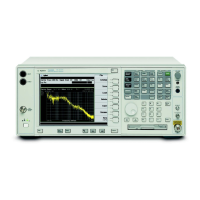Chapter 4 105
Troubleshooting the RF Section (E4446A, E4447A, E4448A)
RF Section Description (E4446A, E4447A, E4448A)
The 3 Hz to 3 GHz RF input signal enters the Lowband assembly at
A20J1. The first component in the RF path is the RF Limiter. This
limiter prevents excessive RF energy from damaging the first mixer
when the input attenuator is set to zero dB. The first mixer up-converts
the 3 Hz to 3 GHz signal to the 3.9214 GHz first IF. The first LO, which
enters the Lowband assembly from the FELOMA, ranges from 3.9214
to 6.9214 GHz. Following the first mixer is a coupler that routes a
portion of the input signal to the first IF overload detector. The first IF
signal leaves the Lowband assembly, routes through the switch in the
First IF Amplifier (FIFA) and the external first IF bandpass filter, then
re-enters the Lowband assembly in the Second Converter section. The
second mixer down-converts the 3.9214 GHz first IF to the 321.4 MHz
second IF. The second LO is at 3.6 GHz.
LO Nulling is the process of reducing the LO feedthrough signal that
appears on screen when the instrument is tuned to 0 Hz. The on-screen
LO feedthrough amplitude is typically reduced 30 dB. The LO null
function can be turned on and off using a switch in the service menu.
With LO nulling applied, the LO’s phase noise contribution to the
analyzer’s noise floor is reduced thereby increasing dynamic range.
This is important when measuring signals close to 0 Hz.
A faulty Lowband assembly will commonly cause low or no signal below
3 GHz, and no LO Nulling. The 3.6 GHz second LO signal is supplied by
the A9 Second LO assembly. The second LO is amplified in the
Lowband assembly before it is applied to the Second Mixer
A failure with the Lowband assembly will likely result in a problem
with signals up to 3 GHz and above 26.8 GHz. Start troubleshooting in
lowband with a 50 MHz input signal. First check for a signal at the
input, A20J1, the First LO at A20J2, and the 2
nd
LO at A20J5 by
referring to the signal conditions given on the overall block diagram.
The 2
nd
LO signal can be checked at A20J6. Similarly the first IF signal
can be verified at A20J3.

